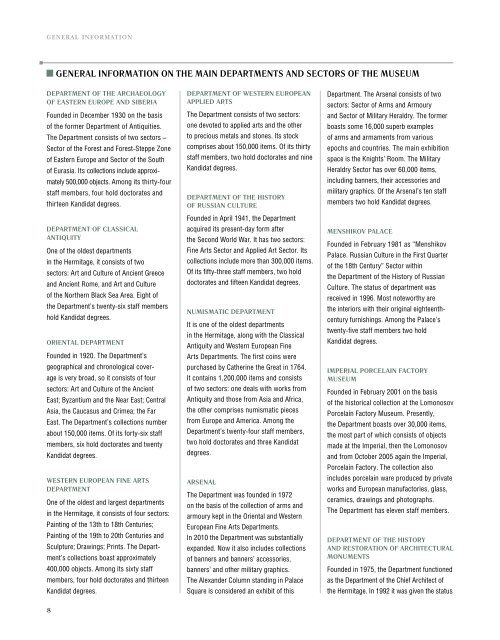The STaTe hermiTage muSeum annual reporT
The STaTe hermiTage muSeum annual reporT
The STaTe hermiTage muSeum annual reporT
Create successful ePaper yourself
Turn your PDF publications into a flip-book with our unique Google optimized e-Paper software.
General InformatIon<br />
J general informaTion on <strong>The</strong> main deparTmenTS and SecTorS of <strong>The</strong> <strong>muSeum</strong><br />
deparTmenT of <strong>The</strong> archaeology<br />
of eaSTern europe and SiBeria<br />
Founded in December 1930 on the basis<br />
of the former Department of Antiquities.<br />
<strong>The</strong> Department consists of two sectors –<br />
Sector of the Forest and Forest-Steppe Zone<br />
of Eastern Europe and Sector of the South<br />
of Eurasia. Its collections include approximately<br />
500,000 objects. Among its thirty-four<br />
staff members, four hold doctorates and<br />
thirteen Kandidat degrees.<br />
deparTmenT of claSSical<br />
anTiQuiTy<br />
One of the oldest departments<br />
in the Hermitage, it consists of two<br />
sectors: Art and Culture of Ancient Greece<br />
and Ancient Rome, and Art and Culture<br />
of the Northern Black Sea Area. Eight of<br />
the Department’s twenty-six staff members<br />
hold Kandidat degrees.<br />
orienTal deparTmenT<br />
Founded in 1920. <strong>The</strong> Department’s<br />
geographical and chronological coverage<br />
is very broad, so it consists of four<br />
sectors: Art and Culture of the Ancient<br />
East; Byzantium and the Near East; Central<br />
Asia, the Caucasus and Crimea; the Far<br />
East. <strong>The</strong> Department’s collections number<br />
about 150,000 items. Of its forty-six staff<br />
members, six hold doctorates and twenty<br />
Kandidat degrees.<br />
weSTern european fine arTS<br />
deparTmenT<br />
One of the oldest and largest departments<br />
in the Hermitage, it consists of four sectors:<br />
Painting of the 13th to 18th Centuries;<br />
Painting of the 19th to 20th Centuries and<br />
Sculpture; Drawings; Prints. <strong>The</strong> Department’s<br />
collections boast approximately<br />
400,000 objects. Among its sixty staff<br />
members, four hold doctorates and thirteen<br />
Kandidat degrees.<br />
deparTmenT of weSTern european<br />
applied arTS<br />
<strong>The</strong> Department consists of two sectors:<br />
one devoted to applied arts and the other<br />
to precious metals and stones. Its stock<br />
comprises about 150,000 items. Of its thirty<br />
staff members, two hold doctorates and nine<br />
Kandidat degrees.<br />
deparTmenT of <strong>The</strong> hiSTory<br />
of ruSSian culTure<br />
Founded in April 1941, the Department<br />
acquired its present-day form after<br />
the Second World War. It has two sectors:<br />
Fine Arts Sector and Applied Art Sector. Its<br />
collections include more than 300,000 items.<br />
Of its fifty-three staff members, two hold<br />
doctorates and fifteen Kandidat degrees.<br />
numiSmaTic deparTmenT<br />
It is one of the oldest departments<br />
in the Hermitage, along with the Classical<br />
Antiquity and Western European Fine<br />
Arts Departments. <strong>The</strong> first coins were<br />
purchased by Catherine the Great in 1764.<br />
It contains 1,200,000 items and consists<br />
of two sectors: one deals with works from<br />
Antiquity and those from Asia and Africa,<br />
the other comprises numismatic pieces<br />
from Europe and America. Among the<br />
Department’s twenty-four staff members,<br />
two hold doctorates and three Kandidat<br />
degrees.<br />
arSenal<br />
<strong>The</strong> Department was founded in 1972<br />
on the basis of the collection of arms and<br />
armoury kept in the Oriental and Western<br />
European Fine Arts Departments.<br />
In 2010 the Department was substantially<br />
expanded. Now it also includes collections<br />
of banners and banners’ accessories,<br />
banners’ and other military graphics.<br />
<strong>The</strong> Alexander Column standing in Palace<br />
Square is considered an exhibit of this<br />
Department. <strong>The</strong> Arsenal consists of two<br />
sectors: Sector of Arms and Armoury<br />
and Sector of Military Heraldry. <strong>The</strong> former<br />
boasts some 16,000 superb examples<br />
of arms and armaments from various<br />
epochs and countries. <strong>The</strong> main exhibition<br />
space is the Knights’ Room. <strong>The</strong> Military<br />
Heraldry Sector has over 60,000 items,<br />
including banners, their accessories and<br />
military graphics. Of the Arsenal’s ten staff<br />
members two hold Kandidat degrees.<br />
menShiKov palace<br />
Founded in February 1981 as “Menshikov<br />
Palace. Russian Culture in the First Quarter<br />
of the 18th Century” Sector within<br />
the Department of the History of Russian<br />
Culture. <strong>The</strong> status of department was<br />
received in 1996. Most noteworthy are<br />
the interiors with their original eighteenthcentury<br />
furnishings. Among the Palace’s<br />
twenty-five staff members two hold<br />
Kandidat degrees.<br />
imperial porcelain facTory<br />
<strong>muSeum</strong><br />
Founded in February 2001 on the basis<br />
of the historical collection at the Lomonosov<br />
Porcelain Factory Museum. Presently,<br />
the Department boasts over 30,000 items,<br />
the most part of which consists of objects<br />
made at the Imperial, then the Lomonosov<br />
and from October 2005 again the Imperial,<br />
Porcelain Factory. <strong>The</strong> collection also<br />
includes porcelain ware produced by private<br />
works and European manufactories, glass,<br />
ceramics, drawings and photographs.<br />
<strong>The</strong> Department has eleven staff members.<br />
deparTmenT of <strong>The</strong> hiSTory<br />
and reSToraTion of archiTecTural<br />
monumenTS<br />
Founded in 1975, the Department functioned<br />
as the Department of the Chief Architect of<br />
the Hermitage. In 1992 it was given the status<br />
8 9




